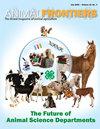代谢调节剂作为家畜生产性能提高技术
IF 3.2
2区 农林科学
Q1 AGRICULTURE, DAIRY & ANIMAL SCIENCE
引用次数: 19
摘要
随着目前和预计的世界人口增长,全球粮食需求和消费的增长将导致对土地、水和能源的竞争加剧。反过来,这将严重影响我们生产粮食的能力,因为迫切需要减少粮食系统对环境的影响(Godfray et al., 2010)。全球化促进了畜牧投入品和产品的贸易,促进了产业增长,同时畜牧生产也经历了一个复杂的技术和地理变化过程(Gerber et al., 2007)。这给畜牧生产者带来了挑战;对农产品的需求不断增长,而资源供应却日益减少,唯一的解决办法就是大幅提高效率。此外,随着新兴经济体的收入增加,对高质量动物蛋白(如肉、奶和蛋)的需求也在增加;因此,联合国粮食及农业组织建议,到2050年,粮食需求将增加70% (Anonymous, 2009)。最近在发达技术和新兴技术方面取得的成功表明,动物产业已经准备好迎接这些新的挑战。为了确保这些技术——如代谢调节剂(包括生长激素)、促性腺激素释放因子免疫,以及口服活性膳食添加剂(如莱克多巴胺、zilpaterol、半胱胺、铬、甜菜碱和膳食神经抑制剂)——能够在整个动物工业中得到有效利用,需要进一步强调它们的接受和发展。由于这些技术的进步,生产者受益于生产效率的提高,而肉类包装商由于瘦肉产量的增加而提高了加工效率。表面上看,消费者也因为肉更瘦、更便宜而受益。然而,有人担心,对提高生产效率和瘦肉产量的关注已经损害了肉类质量(Dunshea et al., 2005)。同样有趣的是,在显然更需要这些技术的时候,市场分化和贸易壁垒等外部影响以及消费者抵制对技术的使用提出了挑战。本文的宗旨是,如果我们要满足全球对动物蛋白日益增长的需求,那么我们必须继续开发和采用提高牲畜效率的技术,但我们必须认识到影响接受的潜在障碍。本文章由计算机程序翻译,如有差异,请以英文原文为准。
Metabolic modifiers as performance-enhancing technologies for livestock production
With the current and predicted increase in world population, growing global demand and consumption of food will result in increasing competition for land, water, and energy. In turn, this will severely affect our ability to produce food as will the urgent requirement to reduce the impact of food systems on the environment (Godfray et al., 2010). Globalization has boosted trade in livestock inputs and products and resulted in industry growth, and concurrently livestock production has undergone a complex process of technical and geographical change (Gerber et al., 2007). This has resulted in a challenge to livestock producers; growing demand for their produce with a dwindling supply of resources, with the only solution being a significant increase in efficiency. Also, as incomes increase in the burgeoning economies, so does the demand for high-quality animal proteins such as meat, milk, and eggs; thus the Food and Agriculture Organization of the United Nations suggests that food requirements will increase by 70% by 2050 (Anonymous, 2009). The recent success in developed and emerging technologies suggests that the animal industries are well placed to prosper through these new challenges. To ensure these technologies—such as metabolic modifiers including somatotropin, immunization against gonadotropin-releasing factor, and orally active dietary additives like ractopamine, zilpaterol, cysteamine, chromium, betaine, and dietary neuroleptics—can be effectively utilized throughout the animal industries, further emphasis is required on their acceptance and development. As a result of these technological advancements, producers have benefited because of improved production efficiencies while meat packers have improved processing efficiencies because of increased lean meat yield. Ostensibly, the consumer has also benefited because meat is leaner and less expensive to purchase. However, there have been some concerns that the focus on increasing production efficiency and lean meat yield has been to the detriment of meat quality (Dunshea et al., 2005). It is also interesting that at a time of apparently greater need for these technologies, there are external influences such as market differentiation and trade barriers as well as consumer resistance that challenge the use of technologies. A tenet of this article is that if we are to meet the increased global demand for animal protein, then we must continue to develop and adopt technologies to improve livestock efficiency, but we must be cognizant of the potential barriers affecting acceptance.
求助全文
通过发布文献求助,成功后即可免费获取论文全文。
去求助
来源期刊

Animal Frontiers
Veterinary-Food Animals
CiteScore
6.50
自引率
5.60%
发文量
74
期刊介绍:
Animal Frontiers is the official journal of the following globally active professional animal science societies:
ASAS, the American Society of Animal Science
CSAS, the Canadian Society of Animal Science
EAAP, the European Federation of Animal Science
AMSA, the American Meat Science Association
These organizations are dedicated to the advancement and dissemination of science-based knowledge concerning animal agriculture. Animal Frontiers provides a novel forum for innovative and timely perspectives that have relevance to understanding the complex dynamics at work through animal agriculture. Animal Frontiers publishes discussion and position papers that present several international perspectives on the status of high-impact, global issues in animal agriculture. Every issue will explore a theme of broad and current interest within animal science and animal agriculture.
 求助内容:
求助内容: 应助结果提醒方式:
应助结果提醒方式:


